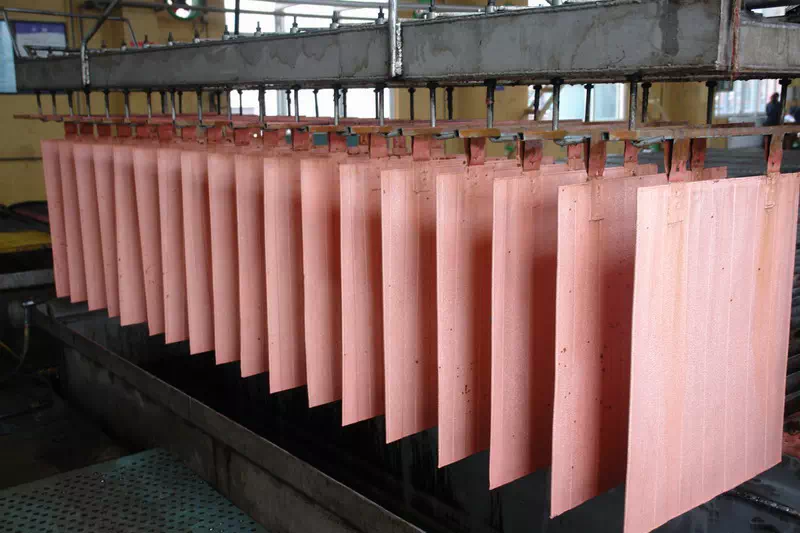Electrolytic refining is the process of anode copper-refining copper. The basic process is to immerse the anode plate and the initial plate (pure copper or stainless steel) in the electrolyte (aqueous solution of sulfuric acid and copper sulfate) in the electrolytic cell at the same time. Under the action of the anode, the copper on the anode enters the electrolyte in an ionic state and is electrochemically precipitated on the cathode to become cathode copper (electrolytic copper), and the valuable metal is precipitated and recovered in the form of anode slime. The basic principle of this method is to use the difference in the potential sequence of copper and impurities to separate the two.

After copper electrolysis
In the traditional electrolysis process, the cathode starting plate is mainly made of pure copper sheet. This process is relatively complicated and requires an independent production system, which is labor-intensive. During the production process, the starting plate needs to be replaced regularly to increase the cost. After the 1970s, the permanent stainless steel cathode method was put into use, that is, the cathode uses a stainless steel starting plate, and the cathode copper is stripped from the stainless steel cathode by an automatic stripping machine. This method not only does not need to establish a separate production workshop of the initial electrode, but also can greatly reduce the cycle of replacing the initial electrode, thereby reducing production and labor costs. At present, this method has been widely used by smelters at home and abroad. The permanent stainless steel cathode method can be divided into ISA method, KIDD method and OT method. The basic form is the same, but the details are slightly different.
Principle of Copper Electrolysis:
Pre-made thick copper (99% copper) as the anode, made of pure copper as a thin sheet as the cathode, and a mixture of sulfuric acid and copper sulfate as the electrolyte. After electrification, copper dissolves from the anode into copper ions (Cu) and moves to the cathode. After reaching the cathode, electrons are obtained and pure copper is precipitated at the cathode (also known as electrolytic copper). Impurities in blister copper, such as iron and zinc, which are more active than copper, will dissolve into ions (Zn and Fe) together with copper. Since these ions are less likely to precipitate than copper ions, the precipitation of these ions on the cathode can be avoided as long as the potential difference is properly adjusted during electrolysis. Impurities less active than copper, such as gold and silver, deposit on the bottom of the electrolytic bath. The copper plates produced in this way, called "electrolytic copper", are of high quality and can be used to make electrical products.
Copper electrolysis equipment:
Copper electrolysis treatment and reuse equipment is mainly based on the principle of copper electrolysis to purify crude copper. The separated metal part is cast into a copper electrolysis anode plate through intermediate frequency smelting for electrolytic copper. Metals, rare earth metals and precious metals often passivate the anode in conventional electrolysis, resulting in the failure of electrolysis. Here, it is recommended to use a pulse automatic electrode change electrolysis system, which not only effectively solves the problem of anode passivation, but also helps loosen and fall off the anode slime. The time adjustment is arbitrarily set by the cycle time relay on the panel of the electrolysis control cabinet.
Copper electrolytic treatment and reuse equipment is composed of multiple IGBT automatic power control modules and belongs to digital pulse power equipment. A semi-automatic vertical mold is used when casting the anode plate. In order to shorten the electrolysis cycle, the thickness of the anode is generally controlled at 10 mm to 30 mm. During electrolysis, the cathode of the electrolytic cell obtains electrolytic pure copper, and the anode produces precious metals such as gold, silver, platinum, and palladium. Anode slime, wash the anode slime, carry out reduction smelting and oxidation smelting in the intermediate frequency furnace and blowing furnace, the smelted precious metal alloy blocks are crushed, and then extract, separate and refine various precious metals through precious metal liquid making. In the production workshop, exhaust gas absorption devices with ozone must be installed in all places where tail gas is generated, and tail liquid diversion devices must be installed in all places where tail liquid is generated to divert the tail liquid to the waste water treatment workshop for treatment and discharge or reuse after reaching the standard.
Thank you for your interest in suny group. If you want to learn more about our E-waste recycling plant, copper wire recycling machine and other machines, Contact us now to find out what we can do for you next project!E-mail:sunymachine@gmail.com | Whatsapp:+8613674945231